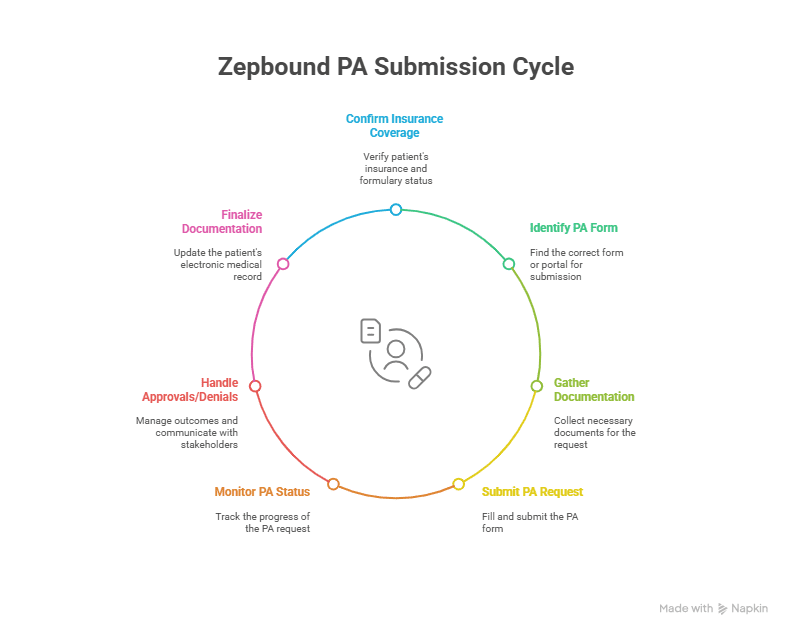On-Demand Outsourcing BPO Services for Healthcare Providers With 24/7 Coverage!
Save up to 70% on staffing costs!
Browse Specialty Staffing ServicesOptimizing PA Submission for Zepound in Weight Management Patients

Prior authorization (PA) is one of the most critical – and often frustrating – steps in helping patients start weight-loss therapy with Zepbound (tirzepatide). Nearly every commercial and government insurer requires documentation before approving this medication, especially for patients with obesity or obesity-related comorbidities like sleep apnea or diabetes.
In this guide, we’ll walk through the entire Zepbound prior authorization process using the example of Patient Y, a 45-year-old adult with a BMI of 36 and history of hypertension. You’ll learn exactly how Staffingly Virtual Medical Assistants (VMAs) handle the full PA submission process – from intake to approval and appeals – in a way that minimizes delays, denials, and burnout for your front desk or clinical team.
What Is Prior Authorization for Zepbound?
Zepbound is a GLP-1 receptor agonist approved for chronic weight management in patients with:
-
BMI ≥30 (obese), or
-
BMI ≥27 with at least one weight-related comorbidity (e.g. T2D, OSA, HTN)
Because of its cost and specialty status, Zepbound requires prior authorization. This means the provider must demonstrate that the patient meets specific clinical criteria before the insurance will pay for the drug. Each payer (Aetna, UHC, Cigna, BCBS, Medicaid, Medicare) has its own rules.
If handled poorly, PA can result in delays, claim denials, and frustrated patients. Done right, it’s a streamlined process that speeds access and reduces administrative headaches.
When Does Zepbound PA Submission Happen?
Staffingly typically initiates Zepbound prior authorization after one of the following events:
-
A new patient evaluation where the provider determines Zepbound is clinically appropriate
-
A follow-up visit where lifestyle changes or other meds failed
-
A specialist (e.g., endocrinologist or obesity med physician) recommends GLP-1 treatment
Once a provider places the order in the EMR or indicates intent to prescribe, our VMAs spring into action. The goal: submit a complete, insurer-specific PA request that gets approved on the first try.
Step-by-Step Zepbound PA Submission Process

Let’s walk through how Staffingly handles the PA submission for Patient Y, step-by-step.
Step 1: Confirm Patient’s Insurance Coverage and Formulary Status
First, our VMA verifies the patient’s insurance details in the EMR and confirms Zepbound is on formulary using:
-
Availity Essentials (for BCBS and other payers)
-
CoverMyMeds
-
Payer portals (e.g., UHCProvider.com, Cigna)
If Zepbound is not covered, we check for alternatives or prep for a formulary exception.
Step 2: Identify the Correct PA Form or Portal
Next, we find the appropriate prior authorization form or digital submission process based on the insurance plan:
-
Aetna: PDF or online form from aetna.com
-
UHC: Electronic form via their provider portal
-
Cigna: National Formulary e-tool
-
BCBS: State-specific (e.g., BlueCrossMA.org)
-
Medicaid: Varies by state
-
TRICARE: Express Scripts portal
We ensure we’re using the most current form and not a generic GLP-1 template.
Step 3: Gather Required Documentation
Using the provider’s chart notes and our internal checklist, we compile the required documentation, including:
-
Diagnosis codes (e.g., Z68.3X, E66.9, I10)
-
Patient’s height, weight, and BMI
-
Comorbidities (e.g., OSA with sleep study AHI score)
-
Proof of 6-month structured lifestyle program
-
List of previously tried weight-loss medications (with dates)
-
Lab values: A1C, glucose, lipid panel (if applicable)
-
Contraindications to other therapies (e.g., failed Wegovy)
We highlight these in the PA form or attach a separate “Medical Necessity Summary.”
Step 4: Fill and Submit the PA Request
Once the form is complete, our VMAs double-check all fields and submit via:
-
CoverMyMeds (preferred for many payers)
-
Payer portals (UHC, Cigna, etc.)
-
Fax (if ePA unavailable)
We attach chart notes, labs, program documentation, and any appeal letters (if resubmitting).
Step 5: Monitor PA Status and Communicate with Pharmacy
We track the status daily through:
-
CoverMyMeds dashboards
-
Portal updates
-
Pharmacy alerts
If we see no response in 48–72 hours, we follow up with the insurance or request a pharmacist status check.
Step 6: Handle Approvals or Denials
If approved – we notify the provider, patient, and pharmacy.
If denied – we do the following:
-
Review the denial reason
-
Draft a Letter of Medical Necessity (LMN) addressing the specific gap
-
Attach missing documentation or clarify errors
-
Resubmit or appeal via insurer protocol
If needed, we schedule a peer-to-peer review for provider escalation.
Step 7: Finalize Documentation in the EMR
Once resolved, we update the patient’s chart with:
-
PA approval/denial details
-
Communication history
-
Auth expiration date
-
Reminder for reauthorization (if short-term)
We also flag any reauthorization tasks in the EMR for future visits.
Why This Process Matters
Zepbound prior auths are time-sensitive and documentation-heavy. Here’s why it pays off to do it right:
-
Fewer denials = faster patient access
-
Stronger provider-pharmacy-insurer communication
-
Clear audit trail for billing
-
Happier patients and less front desk frustration
Staffingly VMAs are trained to catch missing info before it becomes a denial, and to speak the language of insurance when an appeal is needed.
What did we learn ?
Zepbound prior authorization doesn’t have to be a pain. With the right systems, documentation, and VMA support, it’s just another step in personalized patient care. By following the Staffingly process – from insurance check to appeals – providers can feel confident that their patients are getting timely access to this life-changing medication without administrative chaos.
What people are asking ?
1. Is Zepbound covered by insurance?
Yes, but almost all insurers require prior authorization (PA). Coverage depends on your insurance plan, medical history, and whether you meet specific clinical criteria like BMI and comorbidities.
2. What conditions make someone eligible for Zepbound?
You must have:
-
BMI ≥30 (obesity), or
-
BMI ≥27 with at least one weight-related condition like high blood pressure, type 2 diabetes, sleep apnea, or high cholesterol.
3. What documentation is needed to get Zepbound approved?
Insurers usually require:
-
Proof of BMI and weight
-
Diagnosis codes
-
Evidence of a 6-month structured lifestyle program (diet + exercise)
-
Past weight-loss medication history
-
Lab results (e.g. A1c, glucose) if comorbidities apply
4. Why was my Zepbound prior authorization denied?
Most common reasons:
-
Missing documentation (e.g., no proof of prior weight-loss efforts)
-
Incorrect diagnosis codes
-
The medication isn’t on your plan’s formulary
-
The patient didn’t meet the insurer’s strict clinical criteria
5. Can Zepbound be prescribed for sleep apnea?
Yes – if the patient has obesity-related moderate-to-severe obstructive sleep apnea (OSA) and meets BMI and documentation requirements. Some insurers now approve it under those guidelines.
6. Does Medicare cover Zepbound?
Not usually. Medicare Part D does not cover medications used solely for weight loss. However, some Medicare Advantage plans may approve it if the patient has another qualifying diagnosis (e.g. OSA). Appeals are often required.
7. How long does it take to get Zepbound approved?
Turnaround times vary:
-
Commercial plans: 2–5 business days
-
Medicaid: Up to 10 business days
-
Delays happen if documents are missing or need clarification
8. What happens if the prior authorization is denied?
A denial isn’t the end. Staffingly will:
-
Submit a Letter of Medical Necessity
-
Attach missing information
-
File an appeal or request a peer-to-peer review
-
Keep the patient and provider in the loop the whole time
9. Can a virtual assistant handle Zepbound prior auth?
Absolutely. Staffingly VMAs are trained to:
-
Use payer portals
-
Collect documentation
-
Submit PAs electronically
-
Follow up on denials and appeals
This saves providers time and improves approval rates.
Disclaimer
For tailored support and professional services,
Please contact Staffingly, Inc. at (800) 489-5877
Email : support@staffingly.com.
About This Blog : This Blog is brought to you by Staffingly, Inc., a trusted name in healthcare outsourcing. The team of skilled healthcare specialists and content creators is dedicated to improving the quality and efficiency of healthcare services. The team passionate about sharing knowledge through insightful articles, blogs, and other educational resources.
 Book a Demo to Build Your Team Today!
Book a Demo to Build Your Team Today!

 Read Case Studies
Read Case Studies 



 Virtual Medical Assistants
Virtual Medical Assistants



